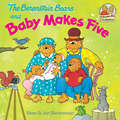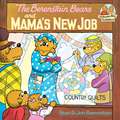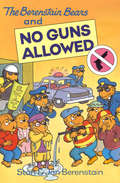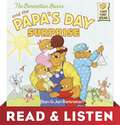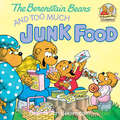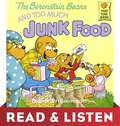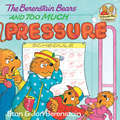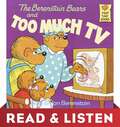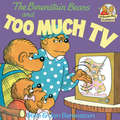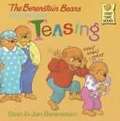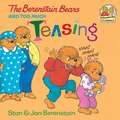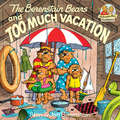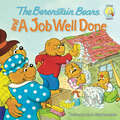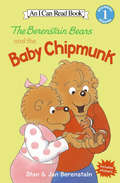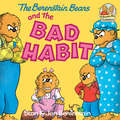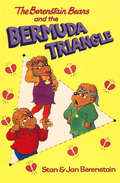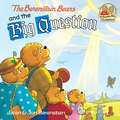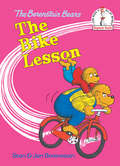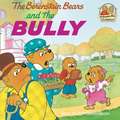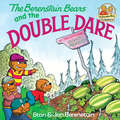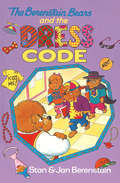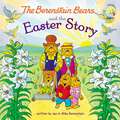- Table View
- List View
The Berenstain Bears and Baby Makes Five (First Time Books(R))
by Stan BerenstainWhat fun! What excitement! What a nuisance. At least that's the way Sister Bear feels. If it isn't being fed, burped, or diapered, it's being dandled, cuddled, or kitchy-kitchy-kooed. Yes, Sister's pretty fed up with the fuss everyone's making over the new baby. Even the dolls make her angry, because they remind her of the baby. Then Sister gets a special homework assignment and, with a little help from wise old Mama, comes to believe that this new baby might just be a nifty addition to the Bear clan. From the Trade Paperback edition.
The Berenstain Bears and Mama's New Job (I Can Read!)
by Stan Berenstain Jan BerenstainWhen Mama turns her quilt-making hobby into a business, the Bear family worries that she won't have time for them. <P><P>But as everyone pitches in to help her, they realize that things aren't so different after all--and they're prouder of Mama than ever!
The Berenstain Bears and No Guns Allowed
by Stan Berenstain Jan BerenstainBear Country School goes zero-tolerant on toy guns When Bear Country School becomes a place filled with the constant rat-a-tat-tat of violent video games, the nerd Ferdy and the jock Too-Tall are forced to team up for a school project on inventions--one that includes guns. It's up to the teachers and students to make things more peaceful--especially when Too-Tall brings a realistic water gun to school as a prank. Bear Country School will learn an important lesson about dealing with weapons and violent play.
The Berenstain Bears and Papa's Day Surprise: Read & Listen Edition (First Time Books(R))
by Stan Berenstain Jan BerenstainRead and listen along with the Berenstain Bears in this charming story that is perfect for Father's Day. Papa says, &“Father&’s Day is nothing but a greeting card holiday.&” If that&’s the way Papa feels, then his family just won&’t celebrate this year. But, as the big day rolls around, and there&’s no card, no gift, and no breakfast in bed, Papa&’s spirits sink lower and lower. That&’s when the cubs spring on him their wonderful Papa&’s Day surprise!This ebook includes Read & Listen audio narration.
The Berenstain Bears and Too Much Junk Food (First Time Books(R))
by Stan Berenstain Jan BerenstainCome for a visit in Bear Country with this classic First Time Book® from Stan and Jan Berenstain. Papa, Brother, and Sister are eating way too much junk food, and it’s up to Mama and Dr. Grizzly to help them understand the importance of nutritious foods and exercise. This beloved story is a perfect way to teach children about the importance of healthy eating and staying active.
The Berenstain Bears and Too Much Junk Food: Read & Listen Edition (First Time Books(R))
by Stan Berenstain Jan BerenstainRead and listen along with the Berenstain Bears! Mama Bear lays down the law when she notices that Papa and the cubs are getting too chubby. With the help of Dr. Grizzly's slide show on how the body works, the Bear family makes a healthful adjustment in their diet and fitness habits. "A most enjoyable introduction to good nutrition and exercise."—Science Books & Films, Starred This ebook includes Read & Listen audio narration.
The Berenstain Bears and Too Much Pressure (First Time Books(R))
by Stan Berenstain Jan BerenstainSister and Brother Bear have activities every day after school, and Mama and Papa have their own interests, too. There isn't much time left over for homework, household chores, or just plain family fun. As the Bears' lives grow more hectic, pressure builds! Finally, the Bears take a realistic look at their responsibilities, talents, and the number of hours in the day and choose after-school activities with care.
The Berenstain Bears and Too Much TV (First Time Books(R))
by Stan Berenstain Jan BerenstainRead and listen along with the Berenstain Bears! When Mama Bear decides her family spends too much time in front of the TV, she bans it for a week. Then the Bear family finds other ways to have fun and keep busy, so they watch less when TV is allowed again—and they don't even miss it. This ebook includes Read & Listen audio narration.
The Berenstain Bears and Too Much TV (First Time Books(R))
by Stan Berenstain Jan BerenstainCome for a visit in Bear Country with this classic First Time Book® from Stan and Jan Berenstain. Papa, Brother, and Sister have a new favorite hobby . . . watching TV. But when Mama feels like they are missing out on all the wonderful things around them, she makes a plan to get them away from the TV and into the outdoors. This beloved story is a perfect way to teach children that there can be too much of a good thing.
The Berenstain Bears and Too Much Teasing
by Stan Berenstain Jan BerenstainBrother Bear likes to tease his sister, but when he's the one who is taunted at school, he understands why sister gets so mad.
The Berenstain Bears and Too Much Teasing (First Time Books(R))
by Stan Berenstain Jan BerenstainBrother Bear is a master at teasing--until the tables are turned and he's the one being heckled for being the principal's pet. And when Brother finally understands that teasing isn't just mean, it's also dangerous, he actually decides to stick up for the new kid at school.
The Berenstain Bears and Too Much Vacation (First Time Books(R))
by Stan Berenstain Jan BerenstainThe Bear family's getaway to the Great Grizzly Mountains is a disaster: the secluded cabin's roof leaks, the lake is just a muddy pond, and the mosquitoes are ravenous. But when the Bears return home and develop their snapshots, they laugh and laugh.
The Berenstain Bears and a Job Well Done (Berenstain Bears/Living Lights: A Faith Story)
by Jan Berenstain Mike BerenstainYoung readers will understand the importance of hard and honest work in this addition to the Living Lights™ series of Berenstain Bears books. Children will learn about the importance of developing a strong work ethic.The Berenstain Bears and a Job Well Done—part of the popular Zonderkidz Living Lights series of books with over 13 million copies sold—is perfect for:Early readers ages 4-8Reading out loud in classrooms, during story time, and at home or bedtimeBirthday gifts, Easter, holiday gift giving, or as a new addition to your e-librarySparking intentional conversations about how hard work pays off and the importance of strong work ethicsThe Berenstain Bears and a Job Well Done is an addition to the Living Lights™ series that:Features the hand-drawn artwork of the Berenstain familyContinues in the much-loved footsteps of Stan and Jan Berenstain in this Berenstain Bears series of booksIs part of one of the bestselling children&’s book series ever created, with more than 250 books published and nearly 300 million copies sold to date
The Berenstain Bears and the Baby Chipmunk (I Can Read Level 1)
by Stan Berenstain Jan BerenstainThe Bear family adopts a curious baby chipmunk in this funny I Can Read story.Brown Eyes explores Papa's desk, Mama's sewing basket, and Papa's pant leg––all the way up to the knee!The Berenstain Bears and the Baby Chipmunk is a Level One I Can Read book, which means it’s perfect for children learning to sound out words and sentences. Whether shared at home or in a classroom, the short sentences, familiar words, and simple concepts of Level One books support success for children eager?to start reading on their own.
The Berenstain Bears and the Bad Habit (I Can Read!)
by Stan Berenstain Jan BerenstainSister Bear enjoys biting her nails and we all know that biting nails is a bad habit. All of the Berenstain Bear family teams up to help Sister Bear kick her habit and keep those nails intact.
The Berenstain Bears and the Bermuda Triangle
by Stan Berenstain Jan BerenstainJealousy shakes up Bear Country School A new student at Bear Country School catches Brother Bear's eye--and all of his attention! But there's something strange about the way the very attractive Bermuda is pursuing him. Bonnie Bear and the Bear Detectives set out to get to the bottom of this mysterious romance. . . and they learn how to deal with jealousy and anger.
The Berenstain Bears and the Big Blooper (First Time Books(R))
by Stan Berenstain Jan BerenstainSister Bear is over at Lizzy Bruin's house watching Trouble at Big Bear High--a big-cubs' video that they probably shouldn't even be looking at--in which two teen bears are having an argument. When one of them gets really really angry, he says a certain word. It's a word Sister has never heard before. At dinner that night Sister tries out this brand-new, stronger-sounding word. When Mama Bear recovers her senses, she has to explain to Sister all about a certain kind of word. It's the kind of word that nobody, not even adults and certainly not cubs, should use at any time, no matter how upset or angry they are.
The Berenstain Bears and the Big Question (I Can Read!)
by Stan Berenstain Jan BerenstainWhen Sister Bear asks her mother about God, Mama tries to explain. They go to services at the chapel in the woods and other bears thank God for different things.
The Berenstain Bears and the Bike Lesson (I Can Read!)
by Stan Berenstain Jan BerenstainWhen Brother Bear gets a brand-new bike, he's all set to ride it-that is, after Papa Bear shows him the rules of the road.
The Berenstain Bears and the Bully (First Time Books(R))
by Stan Berenstain Jan BerenstainWhen Sister Bear takes a beating from Tuffy, the new cub in town, she learns a valuable lesson in self-defense--and forgiveness. A helpful tool for both parents and children in dealing with school bullies. Full color. Copyright © Libri GmbH. All rights reserved.
The Berenstain Bears and the Dinosaurs (with descriptions)
by Stan Berenstain Jan BerenstainBrother Bear's interest in dinosaurs swells to the point where he is driving his whole family crazy. There are clay dinosaurs in the fridge, dinos in Papa's chair, so many dinos in the bedroom that there isn't much room for the cubs. But what can the family do? Other books by these authors are available in this library.
The Berenstain Bears and the Double Dare (First Time Books(R))
by Stan Berenstain Jan BerenstainCome for a visit in Bear Country with this classic First Time Book® from Stan and Jan Berenstain. Brother Bear is feeling peer pressure from Too-Tall-Grizzly and his crew, and before you know it, Brother is accepting dangerous dares that they tell him to do. Will Brother remain a follower, or will he learn the importance of thinking for himself? This beloved story is a perfect way to teach children about being an individual and how to resist bad influences.
The Berenstain Bears and the Double Dare (I Can Read!)
by Stan Berenstain Jan BerenstainBrother Bear and Farmer Ben enjoy a watermelon together and teach Too-Tall Grizzly and his gang that stealing is not a good idea. <P><P>Includes picture descriptions. <P>This file should make an excellent embossed braille copy.
The Berenstain Bears and the Dress Code
by Stan Berenstain Jan BerenstainNew rules collide with Bear Country School's latest spring fashions When Principal Honeycomb goes on vacation and puts Mr. Grizzmeyer in charge, the students at Bear Country School are nervous. The vice principal is strict and very serious about changing the school's dress code. When cubs of every social group start wearing super hip clothes as a way of speaking out against the new rules, the campus becomes a fashion battlefield.
The Berenstain Bears and the Easter Story: An Easter And Springtime Book For Kids (Berenstain Bears/Living Lights: A Faith Story)
by Jan Berenstain Mike BerenstainYoung readers will understand the real meaning behind Easter in this addition to the Living Lights™ series of Berenstain Bears books. Children will discover that Easter is more than candy and egg hunts as they read about the Bear cubs at Sunday school learning about Jesus&’ resurrection and salvation.Join the Berenstain Bears as they explore the true meaning of Easter Sunday and the resurrection of Jesus. Children will discover ways to implement traditional religious values and share God&’s goodness in Zonderkidz The Berenstain Bears Living Lights™ series of books.The Berenstain Bears and the Easter Story: Encourages age appropriate discussions about salvation and Jesus&’ resurrection Is an engaging story about how Easter is more than the Easter bunny, candy, and egg rolls, and is a season of faith Perfect for early reader ages 4-8, reading out loud at home, in a classroom, or Sunday school Perfect for independent reading, Easter basket gift, and holiday?gift-giving The Berenstain Bears Living Lights™ series: Is written and illustrated by Mike Berenstain Features the hand-drawn artwork of the Berenstain family Continues in the much-loved footsteps of Stan and Jan Berenstain with the Berenstain Bears series of books Is part of one of the bestselling children&’s book series ever created, with more than 250 books published and nearly 300 million copies sold to date Look for additional inspirational children&’s picture books in The Berenstain Bears Living Lights™ series, including: The Berenstain Bears and the Easter Story for Little Ones The Berenstain Bears The Very First Easter The Berenstain Bears' Easter Sunday
